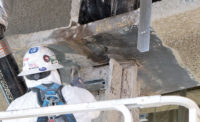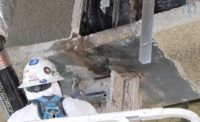Structural Steel
AISC Group Recommends Spec Changes After Salesforce Transit Center Girder Fractures

An AISC task group has recommended structural steel specification changes after the discovery, in 2018, of brittle fractures in plate girders at the Salesforce Transit Center in San Francisco.
Photo courtesy of Transbay Joint Powers Authority
The American Institute of Steel Construction task group, charged with considering model code changes in view of 2018 brittle fractures in twin built-up steel plate girders of vehicle bridges in San Francisco's Salesforce Transit Center, is recommending more than 30 modifications to AISC’s Specification for Structural Steel Buildings. One major recommendation is the addition of a section on brittle fracture and weld access holes.
The task group also advises addressing cyclic loading and strain-sensitive details and connections. And it suggests replacing a section on thermal cutting with new language to address inspection of cut surfaces other than bolt holes.
The proposals are being submitted to AISC's specifications committee for possible inclusion in the 2028 edition of the steel spec. Some of the task group’s other suggestions are already reflected in changes made in the 2022 spec, including clarifications on bolt holes and the addition of the definition of weld access holes in the glossary.
The problem surfaced soon after the 1.2-million-sq-ft transit center, designed by Pelli Clarke Pelli Architects with executive architect Adamson Associates and engineer-of-record Thornton Tomasetti, opened as a bus depot, Aug. 12, 2018. It was shuttered on Sept. 25, after a ceiling installer notice a deep fissure in one of the twin girders of the vehicle bridge spanning 80 ft across Fremont Street.
No Collapse
When the cracks initiated, there was no collapse. The spans were shored almost immediately after the discovery of the fractures. After a structural review of the facility, the depot reopend in July 2019.
The facility has three levels above grade and a 5.4-acre rooftop park. The third-floor Fremont Street tapered plate girders, which span north-south, support the park directly above and the second-floor bus level—via a hanger at the midspan—directly below the girder level.
The Webcor/Obayashi Joint Venture built the facility. The Herrick Corp. is the fabricator of the Fremont Street girders and identical girders that span First Street, which did not fracture.
Peer Review Panel
The task group reviewed recommendations made by California’s Metropolitan Transportation Commission, which is in charge of San Francisco Bay Area transportation planning. The MTC formed a peer review panel to investigate the fractures.
The task group appears to have agreed with the commission panel on points such as the addition of a section addressing the potential for brittle fracture and clarification on weld access holes.
The group also is submitting recommendations to AISC’s manuals committee for possible inclusion in the 2029 Manual of Steel Construction. Those proposals include adding sections about avoiding fatigue and brittle fracture, and on redundancy.
No Blame Cast
Like the MTC peer review panel, the AISC task group report does not cast blame for the fractures on any particular party involved in the transit center project. Lawrence Kruth, AISC’s vice president of special projects, said in a statement that brittle fracture is not a material-only issue. Factors including design, details, fabrication, inspection and loading also play a role.
Weld expert Duane Miller of Lincoln Electric chaired the task group. Other members included Joel Chandler of Owens Steel Co., Robert Conner of Purdue University, James Fisher of CSD Structural Engineers, Chris Hewitt of Simpson Gumpertz & Heger, Larry Muir of the Steel Connection, Thomas Schlafly of AISC, Thomas Murray of Virginia Polytechnic Institute and State University and Jim Schoen of Nucor-Yamato Steel.
The group met in person three times and virtually 32 times, according to AISC.







